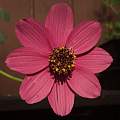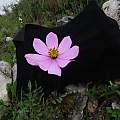Cosmos is a genus of around 25 species of annual and perennial plants in the family Asteraceae from Mexico. Two species frequently used as annual bedding plants are Cosmos bipinnatus (pink, white) and Cosmos sulphureus (orange and yellow). The word 'cosmos' derives from the Greek 'kosmos' for order or adornment. See Revision of the genus Cosmos for historical details.
Cosmos atrosanguineus (Hook.) Voss is commonly called chocolate cosmos; previous names include Bidens atrosanguineus and black bidens. At the end of the 20th. century, gardening pundits firmly placed it in an interesting band of plants described as extinct in the wild and surviving in cultivation as a single non self-fertile clone. Other examples are the saffron crocus (Crocus sativus) and tiger lily (Lilium lancifolium). The situation was not so simple and by 2010 there were reports of Cosmos atrosanguineus plants producing viable seed and the appearance of named cultivars, see plant patent 12587072.
This species was originally found in Zimapán, Hildago, Mexico. It is said to have been introduced to cultivation in 1835 at Ipswich by William Thompson (born 1823, and later to found Thompson and Morgan) who received seeds from Mexico and passed the plant on to Joseph Hooker at Kew. Hooker then described it in the botanical literature. Popular through the early part of the 20th century, by 1970 the only widely known population was at Kew, from which the single non self fertile clone was propagated. Seemingly whilst the pundits spoke, fertile forms were quietly growing in New Zealand gardens, and this is where the new cultivars and seed have appeared.
There has also been mention in the PBS list of seeds being collected in Mexico. A discussion in the light of the species not being extinct begins here.
In 2016 seed was offered on the PBS list and a commercial source appeared.
Someone wrote to the PBS saying that "a self fertile clone was patented in NZ by Russell Poulter in 1996. under the name Cosmos atrosanguineus 'Pinot Noir'. It is has small flower and sets 10-30 seeds per flower. After 'Pinot Noir' was developed another North Island plants breeder and licensed propagator released sterile clones (3-4) to the market all patented in NZ. I understand all chocolate cosmos on the market come from 'Pinot Noir' seeds and all are sterile. The source of the seed lives in the same area that 'Pinot Noir' was developed". The idea here is that the fertile form escaped into gardens in NZ from a plant breeding programme. However the source of the seeds insists the opposite happened. Another patent describes 'Pinot Noir' as "unpatented", it reveals that breeding of chocolate cosmos had been going on for some time.
More information can be found in The Story of Cosmos Atrosanguineus by Graham Rice in The Plantsman for June 2017 (copy here by permission of the RHS).
The Latin term atro means dark and sanguineus means blood-red. The roots are similar to Dahlia tubers and cultivation is similar to Dahlias, with the tubers being put somewhere frost free for Winter (see this posting for crucial differences). It gets its common name from producing a fragrant chemical constituent of vanilla, often chocolate has vanilla added to it.
The centre of the flower is composed of a number of florets, each of which has its own petals. As is typical for Asteraceae there are five stamens with anthers that are fused into a tube, pollen is released inside this and pushed out by the developing style. The florets open one by one, overall this gives the effect of pollen being produced first and then later all the florets being in a pollen receptive state.
First photograph by Uluwehi Knecht, rest by David Pilling. The fourth annotated photograph is of the centre of the flower. The next photograph shows (arrowed) styles breaking through the anthers. The last photo is of a style with developed stigmatic tissue. Given the history above, these photographs are of the same plant; flowers are on stems over three feet high.
Photograph 1 is of roots along with a one pound coin which has a diameter of 22.5 mm, the stem is towards the top right. Photos 2 and 3 are of developing seed. Photo 4 is of seed received from 2013/2014 SRGC seed exchange; visible on the end of the seed are the remnants of the two styles (left hand end of top seed, right hand end of bottom seed). Photo 5 shows shoots in spring.
Photograph 1 shows the contents of a packet of seed, the numbers by each seed are the weights in milligrams (see Cleaning Seeds). Seed was placed in a zip lock plastic bag with moist kitchen towel and kept at room temperature (around 65 °F), germination started within a couple of days. Photos 2 and 3 show the seed from photo 1 which weighed 11 mg. The seed which weighed 3 mg was the only one to not germinate; no surprise; yet it was one picked for the seed photo above; showing it is not easy to tell good seed by eye. Photo 5 is one plant grown from the seeds; by the end of July it was full size and flowering. Photo 6 compares a flower of the usual clone (right) with the flower of a seed grown plant; this particular situation (of an old flower and a new one) exaggerates the differences. It seems that pollen from the seed grown plants produces seeds easily.
Cosmos atrosanguineus 'Chocamocha' is a cultivar, widely available in 2012. It is shorter than the usual one at around 40 cm, and according to vendors has redder and more strongly scented flowers. The first photos trace the development of one flower over three days; Cosmos flowers become lighter with time. In the first photo the green bracts at the back of the flower are visible; the petals around the outside are provided by special ray florets. The last two photos compare 'Chocamocha' (left) with the common form.
Cosmos atrosanguineus 'Cherry Chocolate' is a cultivar given RHS Plant of the Year 2024 second place. Produced by plant breeder Charles Valin, it has larger cherry red flowers and hardier tubers. Photo by Davd Pilling, who says "super easy to propagate by cuttings - just snap off a piece of stem and put it in soil. Prone to powdery mildew"
Cosmos diversifolius Otto ex Knowles & Westc is a lilac flowered species related to Cosmos atrosanguineus.
Cosmos peucedanifolius Wedd. (parsnip-leaved). First published in Chlor. Andina 1: 70 (1856) Native range Peru to NW. Argentina. In garden terms this plant is reported to be a tuberous perennial with pink flowers like the common seed grown annual Cosmos bipinnatus. Hardy in USDA Zone 7. Seeds and tubers are available from commercial sources. A cultivar is 'Flamingo' with candy pink and chocolate scented flowers. Avon bulbs appears to have been an early populariser of the species in the UK, it is in their 2020 catalogue. The species was mentioned in the July 2010 edition of the UK journal Horticulture Week.
There is a Plant Delights Nursery Inc web page which offers the "Dutch selection" Flamingo.
Jamie Compton told us "according to my collection notes: CDPR 3159 (James Compton, John d’Arcy, Nori Pope and Martyn Rix) collected this species on Tuesday 1 February 2000 between Salta and Cachi in north western Argentina at 2440 m on grassy slopes of the eastern Andes.
On arrival in the UK seed germinated immediately and small tubers were given by me to Alan Street of Avon Bulbs in Somerset from where this plant has subsequently been distributed.
The species was first described by Hugh Weddell in Chloris Andina vol. 1: 70 (1856) from Bolivia prov. Tomina, 'in graminosis excelsis montis Curi'. Although borne in Gloucestershire Weddell spent many years in the service of the French in S. America searching for quinine trees (Cinchona officinalis) in order to send seeds back to the Jardin des plantes in Paris."
Photo from iNaturalist taken by Manuel Roncal in Oxamarca, Perú March 2022 and shared under a CC BY-NC license























